Related Research Articles

Bezique or Bésigue is a 19th-century French melding and trick-taking card game for two players that came to Britain and is still played today. The game is derived from Piquet, possibly via Marriage (Sixty-six) and Briscan, with additional scoring features, notably the peculiar liaison of the and that is also a feature of Pinochle, Binokel, and similarly named games that vary by country.

Ombre or l'Hombre is a fast-moving seventeenth-century trick-taking card game for three players and "the most successful card game ever invented."
Marjapussi is a traditional Finnish trick taking game for 4 players playing in 2 partnerships and is one of the Mariage family, its key feature being that the trump suit is determined in the middle of the play by declaring a marriage. There are variants of Marjapussi for two and three players.
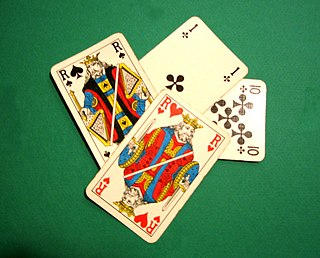
Tarabish, also known by its slang term Bish, is a Canadian trick-taking card game of complex rules derived from Belote, a game of the Jass family. The name is pronounced "tar-bish", despite the spelling. It is played primarily by the people of Cape Breton, Nova Scotia, in Canada, where, according to one source, it was brought in 1901 by a Lebanese immigrant George Shebib. On the other hand, following comprehensive research Kennedy (1996) states that opinions as to its origin vary and that no "definitive roots may ever be determined."
Pedro is an American trick-taking card game of the All Fours family based on Auction Pitch. Its most popular variant is known as Cinch, Double Pedro or High Five which was developed in Denver, Colorado around 1885 and soon regarded as the most important American member of the All Fours family. Although it went out of fashion with the rise of Auction Bridge, it is still widely played on the western coast of the United States and in its southern states, being the dominant game in some locations in Louisiana. Forms of the game have been reported from Nicaragua, the Azores, Niobe NY, Italy and Finland. The game is primarily played by four players in fixed partnerships, but can also be played by 2–6 individual players.

Klaberjass or Bela is a trick-taking Ace-Ten card game that is most popular in German communities. In its basic form it is a 9-card trick-and-draw game for two players using a 32-card piquet pack.
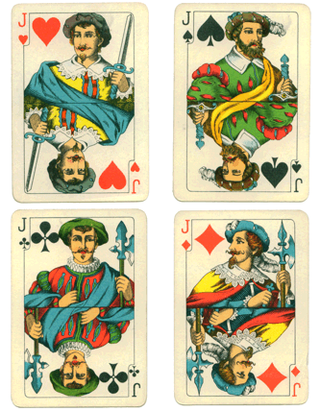
Polskpas, Polsk Pas, or Polskt Pass is a Scandinavian 5-card plain-trick game for four individual players using 24 cards. Eldest hand has the first right to accept or make trumps. As is typical for Schafkopf card games, which are normally point-trick games, the four Jacks are known as Wenzels and form permanent highest trumps. Polskpas is similar to the historical German game of Kontraspiel.

Tippen, also known as Dreiblatt, Dreikart, Drei Karten, Dreekort, Kleinpréférence or Labet, is an historical German 3-card, plain-trick game which was popular as a gambling game for three or more players. The Danish version of the game was known as Trekort and more elaborate Swedish variants include Knack and Köpknack. It appears to be related to the English game of Three-Card Loo. It was banned as a gambling game in some places.
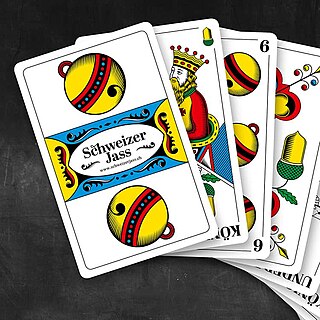
Chratze is a trick taking card game, mainly played in the German-speaking part of Switzerland as well as in Bavaria. It is one of over 70 variants of Jass and played with a pack of 36 cards, either a Swiss-German or French one. It appears to be related to the Austrian game, Kratzen.

Bestia is an Italian card game. It is a gambling game and is similar to Briscola and Tressette. The word bestia means beast.
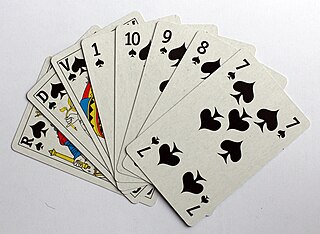
Triomphe, once known as French ruff, is a card game dating from the late 15th century. It most likely originated in France or Spain and later spread to the rest of Europe. When the game arrived in Italy, it shared a similar name with the pre-existing game and deck known as trionfi; probably resulting in the latter becoming renamed as Tarocchi (tarot). While trionfi has a fifth suit that acts as permanent trumps, triomphe randomly selects one of the existing four suits as trumps. Another common feature of this game is the robbing of the stock. Triomphe became so popular that during the 16th century the earlier game of trionfi was gradually renamed tarocchi, tarot, or tarock. This game is the origin of the English word "trump" and is the ancestor of many trick-taking games like Euchre and Whist. The earliest known description of Triomphe was of a point-trick game, perhaps one of the earliest of its type; later, the name was applied to a plain-trick game.
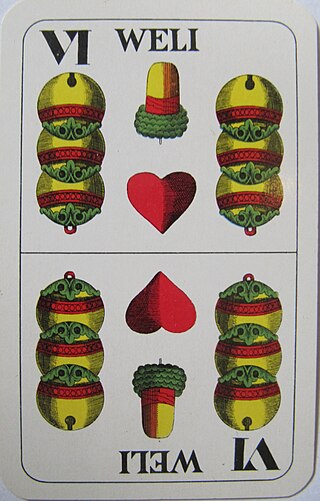
Mauscheln, also Maus or Vierblatt, is a gambling card game that resembles Tippen, which is commonly played in Germany and the countries of the old Austro-Hungarian Empire.
Tatteln, also called Franzefuß and Därde, is an historical card game for two players that is played with a pack of 32 French or German playing cards. The rules resemble those of Piquet and Mariage (Sixty-six), and David Parlett refers to it as a trick-and-draw version of the international classic, two-hander, Klaberjass.
Bester Bube, also Fiefkort mit 'n besten Buren, is an historical German card game for 3–6 players played with a Piquet pack. It is one of the Rams group of card games characterised by allowing players to drop out of the current game if they think they will be unable to win any tricks or a minimum number of tricks. It may be an ancestor of Five-Card Loo.

Norseman's knock or Norrlandsknack is a classic Swedish card game for 3 to 5 players, known since the mid-1800s. It is traditionally played for money. The game is about winning as many tricks as possible and above all not being completely left without a trick.

Knack is a Swedish card game, mainly played for money, in which the aim is to win at least one of the three tricks. It is also known as Trekort or Trikort, although that usually refers to a more basic game of Danish origin that is probably its progenitor.

Svängknack is a Swedish card game for 6 to 8 players that is a further development of Knack and, like the latter, is mainly played for money.

Köpknack is an old Swedish card game which is a development of Knack and, like the latter, is mainly played for stakes. The game is also known as Trekort which, however, usually refers to a simpler version of Danish origin that may have been its progenitor.

Zwikken is a Dutch gambling game of the trick-and-trump type using playing cards and designed for three to six players. It is "an old soldiers' game", still popular among the military today.
Hahndreier or Hanrei is an 18th-century Danish and north German children's and family round game played with cards that is still played in some forms today.